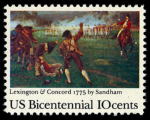(The year 2025 is the 250th anniversary of the beginning of the American Revolution, and the year 2026 is the 250th anniversary of American Independence, so this month we are beginning a two-year Homeschool American Heritage tour that will invite you and your students to learn about parks, historic sites, and national monuments all across the United States. Get out your homeschool atlas and almanac and come along with us!)
Georgia is our homeschool state-of-the-week, so why not spend a few minutes today with your students learning about one of Georgia’s most important and tragic historic places: Andersonville National Historic Site, which commemorates American prisoners of war.
![[Homeschool American Heritage]](https://upload.wikimedia.org/wikipedia/commons/thumb/1/1d/Andersonville_Prison.jpg/1259px-Andersonville_Prison.jpg)
Nearly 13,000 men died on the grounds of what is now Andersonville National Historic Site, “a site that became infamous even before the Civil War ended. Their burial grounds became Andersonville National Cemetery, where veterans continue to be buried today. This place, where tens of thousands suffered captivity so others could be free, is also home to the National Prisoner of War Museum and serves as a memorial to all American prisoners of war.”
Andersonville National Historic Site began as a stockade built about 18 months before the end of the U.S. Civil War to hold Union Army prisoners captured by Confederate soldiers. Located deep behind Confederate lines, the 26.5-acre Camp Sumter (named for the south Georgia county it occupied) was designed for a maximum of 10,000 prisoners. At its most crowded, it held more than 32,000 men, many of them wounded and starving, in horrific conditions with rampant disease, contaminated water, and only minimal shelter from the blazing sun and the chilling winter rain. In the prison’s 14 months of existence, some 45,000 Union prisoners arrived here; of those, 12,920 died and were buried in a cemetery created just outside the prison walls.
The cemetery site serving Camp Sumter was established as Andersonville National Cemetery on July 26, 1865. By 1868, the cemetery held the remains of more than 13,800 Union soldiers whose bodies had been retrieved after their deaths in hospitals, battles, or prison camps throughout the region. Andersonville National Cemetery has been used continuously since its founding and currently averages over 150 burials a year. The cemetery and associated prison site became a unit of the National Park System in 1970. (nps.gov)
You can find a wealth of additional information about the park’s history, landscape, location(s), and visitor facilities on the Andersonville National Historic Site website from the National Park Service.
![[Homeschool American Heritage]](https://upload.wikimedia.org/wikipedia/commons/thumb/1/16/Andersonville_National_Cemetery_2.jpg/1024px-Andersonville_National_Cemetery_2.jpg)
Explore America’s National Parks, National Historical Parks, National Historic Sites, National Monuments, and more via Wikipedia and via the U.S. National Park Service’s website today.
What historical American treasures will you and your students be exploring in your homeschool this Cygnus Term? 🇺🇸
❡ The great globe itself: This is one of our regular Homeschool Geography posts featuring important natural and historical sites in the United States. Print your own copy of our River Houses American Heritage Calendar and follow along with us, and add your name to our weekly mailing list to get great homeschool teaching ideas delivered right to your mailbox all through the year. 🌎
❡ We set to-day a votive stone: If you want a great long-term history and geography project for your homeschool, explore the Historical Marker Database online (hmdb.org) and make a plan to find all the markers that are listed in your local area. Add any new ones you know of that are missing, and add new photos or descriptions for the ones already included. Your students will gain a better appreciation for your local community and will learn a wealth of new information about history and geography. 🏛
❡ Print this little lesson: Down at the bottom of this post you’ll find a special “Print” button that will let you create a neat and easy-to-read copy of this little lesson, and it will even let you edit and delete sections you don’t want or need (such as individual images or footnotes). Give it a try today! 🖨
❡ Books in the running brooks: You can always turn to your River Houses atlas and almanac for more information about any of our homeschool states-of-the-week. The almanac has detailed profiles of all the U.S. states and territories, and the endpapers of the atlas are indexes that will show you where all of the individual national and regional maps may be found. 📚
❡ Homeschool calendars: We have a whole collection of free, printable, educational homeschool calendars and planners available on our main River Houses calendar page. They will help you create a light and easy structure for your homeschool year. Give them a try today! 🗓
❡ Support our work: If you enjoy our educational materials, please support us by starting your regular Amazon shopping from our very own homeschool teaching supplies page. When you click through from our page, any purchase you make earns us a small commission at no extra cost to you. Thank you for helping us to keep going and growing! 🛒
❡ Join us! The aim of the River Houses project is to create a network of friendly local homeschool support groups — local chapters that we call “Houses.” Our first at-large chapter, Headwaters House, is now forming and is open to homeschoolers everywhere. Find out how to become one of our founding members on the Headwaters House membership page. 🏡




